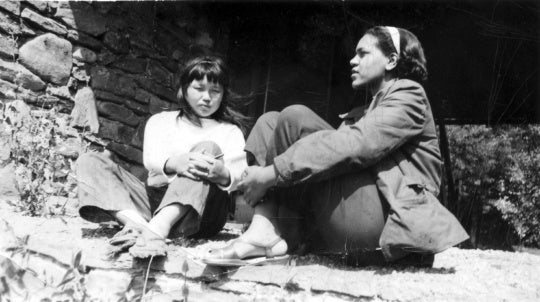
Air Jordan and Al Jazeera meet Cronenberg’s Videodrome in P. Seth Thompson’s solo exhibition “Insufficient Data for an Image” at Sandler Hudson Gallery, on view through May 6. An intimate show of digital prints and a video, the work achieves enough variety while maintaining a consistent upbeat vibe of late ’80s throwback pixelated pop, shadowed slightly by a hint of social violence and voyeurism. Spending time here imparts a sense of Thompson’s creative ethos, evoking the seriousness of a cable news junkie yet also the snarky levity of a pop-culture historian.
The artwork often starts with a photograph found online. Some of these sources are still recognizable (tiny portraits of Donald Trump, a Warhol-esque patterning of the Kool-Aid Man), while others are transformed beyond legibility, dissolving into maroon dandruff debris or blue-white TV noise.
One prominent image, for example, shows the imposing sun-bleached silhouette of two athletic men captured from a low-angle camera. Beyond that, the exact subject matter is mysterious, a madcap guessing game that the artist encourages with the roguishly verbose title American soldier, obviously very skilled in martial arts, single-handedly takes on mercenaries in the Philippines.

Looking for more clues, visitors might find Thompson’s statement containing such dark references as the Jonestown massacre (infamously involving death by poisoned grape-flavored beverage). Titles of other works include mention of World War II, the Menendez brothers (who went on trial in 1994 for murdering their parents), and Amy Fisher (who at the age of 17 became another television pseudo-celebrity in the wake of violent crime).
Despite its name, The End of Innocence (Rebecca Shaeffer’s Murder) has a kind of soothing nocturnal beauty. The print comprises a four-by-four grid of repetition, a dance of colored light photographed against darkness like the inside of a long kaleidoscope, perhaps a sequence over time. Rebecca Shaeffer was a young Hollywood actress murdered by a stalker in 1989. Still, there is nothing explicitly sinister captured in Thompson’s imagery. The real-world allusion is haunting, yes, but also draws the viewer back to reinspect and appreciate videographic artifacts of blurred color or the numerical date stamp in frame.

Not everything is terrifying in Thompson’s world, though. Enter Bruce Almighty, a composition of 10 prints featuring a cartoon shark from Disney’s Finding Nemo. Specifically, these photographs capture visitors to Bruce’s Shark World at the Epcot theme park near Orlando. Candid in the extreme, children pose underneath the beast’s gigantic plastic jaws or even pretend to be devoured inside. Thompson places the photos in a cross shape, heightening the silly voyeuristic weirdness of stolen vacation memories and stretching his mass-culture theme to hyperbole.
An 11-foot-wide arrangement of digital stills covers one of the gallery walls, its pixelated chaos helping to flesh out the exhibition with a chorus of horizontal lines and rectangles of blue nothingness. Random messages whisper here and there—“my head is a prison and nobody visits,” “4 real VHS noise 2 pack”—in small monospaced font, akin to the heads-up display of a handheld camcorder. All of these images were sourced simply, via Google image search.

Thompson’s video work Disentangled adds the show’s final touch. A looping digital clip documents the slow unwinding of black VHS type, silently dangling from above and spiraling down until the entire roll forms a restful heap of dark inky ribbon. The videotape motif echoes several other works, including Malfunction, Need Input, which seems to be a parody portrait of an invisible man with VHS cassettes for eyes.
While not overwhelming in terms of innovation, scale, or technical prowess, “Insufficient Data” has enough subversive smarts, visual pop, and nostalgic approachability to hold its own. Plus, it demonstrates consistency in the artist’s themes over the past few years without going stale or losing relevance.
Society’s spectacle is arguably more pervasive today than ever before. In the age of fake news and instant YouTube celebrity, Thompson’s nostalgic tour of recent decades provides a mirror worthy of reflection.
Jeremy Abernathy is a cofounder of BURNAWAY and has written extensively on art in Atlanta.




